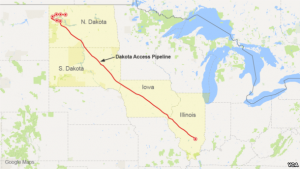The Dakota Access Pipeline: No DAPL
The Dakota Access Pipeline is a crude oil pipeline that is being constructed to span 1,200 miles and carry 570,000 barrels of oil from North Dakota to Illinois every day. The project is worth 4 billion dollars and was expected to be completed in late 2016. According to Justin Worland of TIME Magazine, the federal government was required to engage the Standing Rock Sioux Tribe in the decision of the proposed route of the pipeline because it crossed over Lakota treaty land but did no such thing. The project was temporarily blocked in September, awaiting a new review, but the federal court gave the go-ahead for the project to continue. The pipeline is not only a threat to water sources but has sparked the controversy of eminent domain and the respect that law enforcement have for Native Americans.
The Dakota Access Pipeline’s proposed route was set to head from Stanley, North Dakota to Bismarck, North Dakota, but was abandoned because of the risk it could pose to Bismarck residents and the cost of production. The Bismarck route would have encompassed eleven extra miles of pipeline length and would put a lot of extra pressure on the company to stay at least 500 feet away from homes and residential areas. But how is that any different than the Sioux territory? It’s not. The pipeline is set to run underneath Lake Oahe, which attaches to the Missouri River that according to the Izaak Walton League of America, runs water to millions of people. The body of water borders the eastern side of Standing Rock Sioux territory.
The Standing Rock Reservation lost thousands of acres of land in the 1960s, when the Army Corps of Engineers built five dams on the Missouri River, which forced some Native Americans from their homes and towns. Lake Oahe was created by this flooding, and there are still lost towns underneath it today. Because of the flooding, financial stress was created because of the ways of life that were lost. The Standing Rock Sioux Reservation is one of many tribes who still struggles with poverty today.
In an interview with reporter Michel Martin, Hawaii U.S. Congresswoman and veteran Tulsi Gabbard stated her response to the protests taking place at Standing Rock, “And that ignited a fire within me many, many years ago, and felt in some ways kindred spirit to the threat that the people here at Standing Rock have been fighting against, which is not different from the unfortunate lead poisoning that the people of Flint, Michigan have been enduring, and is not different from a threat that we face in Hawaii right now where one of our largest water aquifers sits beneath a fuel storage tank carrying millions and millions of gallons of fuel.”
Over 2,000 veterans were expected at the Oceti Sakowin camp, but many more arrived just hours before President Barack Obama issued the veto decision. Many of them traveled across the country to get to Standing Rock for different personal reasons, but one of the most prominent is the need to protect protesters from law enforcement. Rob McHaney, who served for 30 years in the U.S. Navy, gave his statement on why he came to the camp. “As a veteran, I took an oath to help those who can’t help themselves. And nowhere in that oath says I should go help an oil company.”
Sunday November 20th, a group of protesters attempted to peacefully remove a roadblock that law enforcement had set in the middle of Highway 1806 to reopen the highway when law enforcement allegedly came thundering in. Law enforcement came at protesters with rubber bullets, tear gas, concussion grenades, mace, pepper spray, and freezing cold water. In 23 degree weather, the battle raged on; hundreds were either treated for hypothermia, pelted by rubber bullets, or ambushed by harmful sprays.
“The number one thing has still been the safety for everybody,” stated Morton County Sheriff Kyle Kirchmeier at a Monday evening press conference, in defense of the actions of law enforcement against ‘violent protesters.’ But you decide what is considered more violent: police dressed in riot gear with weapons or Native American people linking arms to protest the injustices being done against their people.
One of the most devastating injuries belonged to Sophia Wilansky, a 21-year-old New York resident who may lose her arm. Wilansky was handing out bottles of water to other protestors when law enforcement attacked her, their devices ripping apart her arm and severely impacting her mobility. According to Sophia’s father, Wayne Wilansky, the blast completely destroyed the bones, muscles and arteries in his daughter’s left arm. He also said his daughter’s body had welts from more than a dozen rubber bullets, and doctors found grenade shrapnel in her arm.
Although some Native Americans have old wounds that will not heal quickly towards white men, the violence between law enforcement and protesters should not be happening. Drinking water is essential to life, and if it is polluted, water that millions of people drink will be contaminated. Everything that has to do with this pipeline either has the ability to directly affect your daily life or the environment. Maybe your drinking water could be contaminated, your land could be taken, a veteran who fought for your freedom could be in danger, or a water protector who fights not only for their ancestors, but for your water is being brutally attacked for having a voice.
Will you use your voice?













